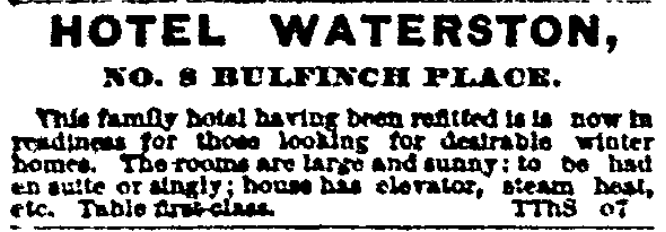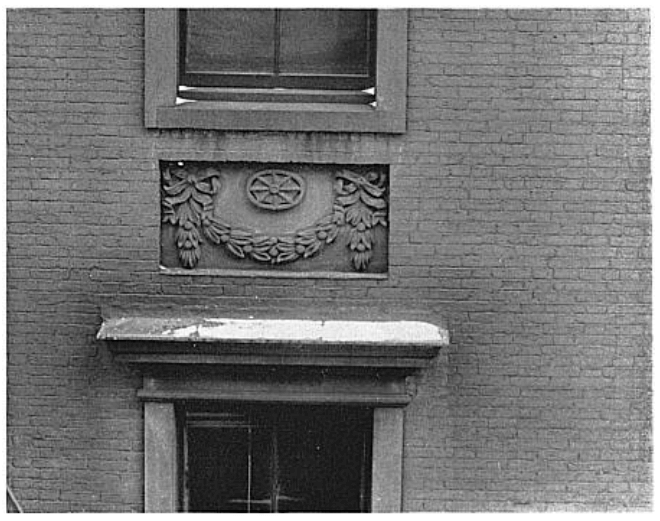Hotel Waterston
The Hotel Waterston, built in 1874 through a remodeling and expansion of the Charles Bulfinch House on 8 Bulfinch Place in the West End, maintained Bulfinch’s facade while adding additional stories. The Waterston had many prominent guests, including Walt Whitman, during the late nineteenth century, and the hotel stayed in business until it was demolished by urban renewal in 1961.
“The last week of the 19th century has been an ideal one for the real estate men of Boston,” said the Boston Globe on December 30, 1900. The most notable transaction that week was Horace W. Baxter, Jr. ‘s purchase of the Hotel Waterston from David L. Webster. Baxter had already owned an estate, on Bowdoin Street, which adjoined the hotel. The Hotel Waterston resided on 8 Bulfinch Place, with the facade that survived of the Charles Bulfinch House at that address; the hotel was assessed at $56,000 ($1,930,000 in 2022 dollars), though the sale price was not disclosed in the report from Edward T. Harrington & Co. (a real estate brokerage in Boston). The Globe described the Hotel Waterston as “the famous West End hotel,” and reminded readers that it was the “former home for many years of Walt Whitman, [William Dean] Howells, and other literary men.” The Hotel Waterston, given its physical ties to Bulfinch and its longevity up to the urban renewal period (when it was demolished on September 4, 1961), represents the West End’s neighborhood history over nearly two centuries.
The Charles Bulfinch House, designed by Bulfinch in 1793 or 1794, was occupied by the merchant William Clapp from 1797 to 1811, when Clapp died and his wife deeded the house to Henry Rice, the merchant who occupied 8 Bulfinch Place as a winter home until 1841. On November 5, 1841, Rice sold the Bulfinch House to merchants Robert Waterston, Isaac Pray, and John Hall, co-owners of “Waterston, Pray and Company.” Robert Waterston assumed sole ownership of the house in 1850 and occupied it until his death in 1869; Waterston’s executors sold 8 Bulfinch Place to David L. Webster in 1870. In 1874, Webster made significant alterations to the Bulfinch House to convert it into a hotel, adding three-and-a-half stories, changing the window openings, and building a new entrance. None of the interior of the original Bulfinch House survived construction, though elements of the original facade remained. For this reason, architect Abbott Lowell Cummings remarked in 1961 that “the building as it had been known to recent generations of Bostonians was largely the work of the 1870s.” The construction of the hotel had cost Webster more than $90,000, though the investment paid off. The Globe reported that “in its day,” the building “was considered a superior type of architecture of the sixties [1860s]” and that the hotel was advantaged by its “choice location in the midst of Boston’s wealth and culture.”
Hotel Waterston was family-owned, but not by the Waterston family: Clark’s Boston Blue Book in 1890 reported that the hotel was owned by “Pyne, Mrs. & family.” The Globe reported that “the hotel was named in honor of Rev. Dr. Waterston, the eminent Scotch divine, the memory of whose able ministry yet lingers in the minds of our oldest residents.” The Rev. Dr. Waterston was actually Robert Waterston’s son, Robert Cassie Waterston, born in Boston in 1812; the elder Robert, a merchant, was born in Scotland in 1778, and Robert C. was a Unitarian minister in Boston. The Hotel Waterston’s newspaper advertising told of a well-furnished hotel with comfortable rooms. On November 20, 1876, the following appeared in the Globe: “TO BE LET–At Hotel Waterston, No. 8 Bulfinch Place. A sunny suite of eight rooms, with all modern conveniences, and heated by steam; open fireplaces; excellent arrangements for economical housekeeping. Apply to the Janitor” [the nineteenth-century meaning of “janitor” was a guard who watched the door]. Repairs continued up to 1890, and the retrofitting was referenced by another advertisement on October 11 that year, which described the Hotel Waterston as a “family hotel” (meaning it had enough space to accommodate families) available to “those looking for desirable winter homes.” When heating one’s home could often be a difficult logistical challenge for Bostonians in the eighteenth and nineteenth centuries, the Hotel Waterston served as a comfortable, modern “winter home” for those who could afford it.
Throughout the nineteenth century the Hotel Waterston’s “spacious apartments were the home of many persons distinguished in state, church, literature, drama and commerce.” The Globe concluded in 1900 that “there is not another building in Boston that can boast of such a number of noted guests through a long period of years as hotel Waterston.” The eminent poet Walt Whitman lived at the Hotel Waterston for three years. Whitman traveled to Boston in 1881 to supervise the printing of his latest re-write of Leaves of Grass, and he stayed at the Hotel Waterston during that time. On August 27, 1881, Whitman wrote a letter to Louisa Orr Whitman, Walt’s sister-in-law (who married his brother George in 1871), in which he wrote:
All goes satisfactory here—I keep as well as usual—have a very good room & board in a kind of half hotel half boarding house, the hotel Waterston—the landlady Mrs Moffit, has a hundred guests when full, mostly families, very nice—capital table, (most too good for me, tempts me too much)
Whitman paid Eva Moffit $8 a week to live at the Hotel Waterston in 1871. Moffit managed the Hotel Waterston and had leased the building for over 25 years by the time it was sold to Baxter in 1900. $1 in 1871 has the equivalent purchasing power of $23.70 in 2022, making $8/week the equivalent of paying $192/week in today’s dollars. The Hotel Waterston advertised in 1895 that its prices were “moderate,” and that the hotel’s prime location in the West End made it a “three minutes’ walk from [the Boston] Common.”
Some other notable guests during the late nineteenth century included novelist William Dean Howells (the “Dean of American Letters,” who lived at the hotel with his family for three years), Eben Tourjėe (appointed dean of Boston University’s college of music in 1871, and Col. Frank Howe (the newspaper reporter who became Vermont’s lieutenant governor in 1912). The novelist Ellen Russell Emerson stayed at the Waterston, as well as the British actor Fanny Vining, known as “Mrs. E.L. Davenport” for her marriage to actor Edward L. Davenport (born in Boston). Jane G. Austin, the prolific author who wrote novels about the Pilgrims (and likely used her middle name to distinguish herself from Jane Austen), died at the Hotel Waterston on March 31, 1894.
When Horace Baxter purchased the Hotel Waterston in 1900, he intended to connect the hotel with his home next door “in anticipation of the great improvements which are going on in that vicinity, notably the changing of Bowdoin St.” This expectation reflected how redevelopment of the West End was ongoing, piece by piece, at the turn of the twentieth century. The updating of streets in particular had ramifications for historic buildings, such as the home of Dr. Joseph Stevens Jones (d. 1877), the West End’s playwright and physician whose 1 Bowdoin Street home was torn down in 1924 following the widening of Cambridge and Court Streets. The Hotel Waterston stayed in business until its demolition on September 4, 1961 by the Boston Redevelopment Authority, during its major land clearance projects in the West End for urban renewal. Abbott Lowell Cummings, the leading expert in early New England architecture who vehemently opposed “slum clearance” for its devastation of the West End’s historic architecture, visited the Hotel Waterston to measure and study the surviving facade of the Charles Bulfinch House months before that fateful September day.
As a successful hotel, and the physical afterlife of the Bulfinch House, the Hotel Waterston connected multiple centuries of West End history up until its end by urban renewal.
Article by Adam Tomasi
Source: Boston Globe/ProQuest (“Display Ad 9 – No Title,” October 11, 1890, page 2; “Display Ad 3 – No Title,” July 11, 1895, page 1; “The Real Estate Market,” December 30, 1900, page 10; American Paintings in the Metropolitan Museum of Art (for Henry Rice); WEM-Abbott Lowell Cummings; WEM–Dr. Joseph Stevens Jones; Boston Athenaeum; In2013Dollars.com; New England Conservatory; Ann Arbor District Library; “Keeping Warm in Early America,” by Richard Klingenmaier (Winter 2015); The Walt Whitman Archive; University of Michigan; Clark’s Boston Blue Book (1890); Abbott Lowell Cummings, “Charles Bulfinch and Boston’s Vanishing West End” (1961); Charles Alpheus Place, Charles Bulfinch, Architect and Citizen (Houghton Mifflin, 1925)














